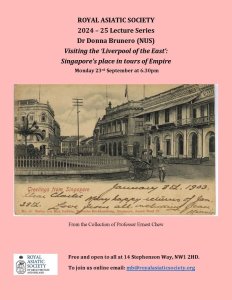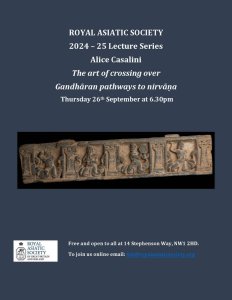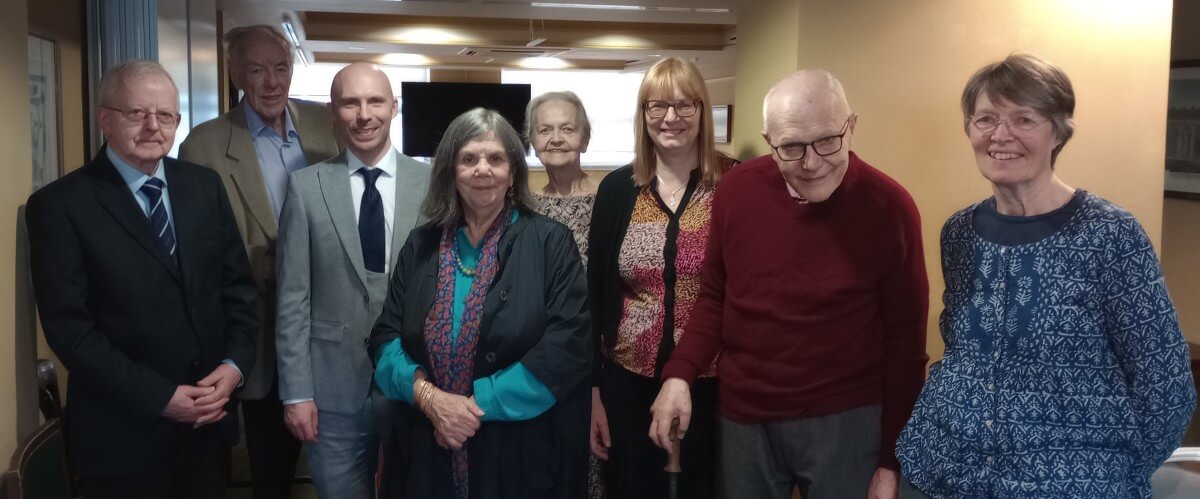Farewell to Dr Roger Parsons, our Longstanding Volunteer
On Friday 6 September we held a farewell lunch for Roger Parsons, a volunteer who has served the Society for nearly 20 years. At the lunch we were joined by Kathy Lazenbatt, the former Librarian, as well as several members of the Council, Barbara Brend, Gordon Johnson, and Lionel Knight, Roger’s partner, Robert Gwynne, and current volunteer Evgenia North. It was a poignant and happy occasion as we celebrated the work Roger has undertaken and the many hours of service he has given. We are very grateful to Roger, and to all our volunteers, who consistently give time to work with the Collections enabling them to become more accessible for researchers. Roger not only gave of his time but also shared his extensive knowledge both in areas of the Collections and in so many other areas too.
Roger agreed to write a blog post about his time volunteering at the Society. He has chosen to write about his involvement with cataloguing the Society’s book collections. Here are his words:
RAS Cataloguing
What I have been doing
I have been volunteering at the RAS since I retired as Librarian at the Buddhist Society in 2005, a role which I had been covering since I retired from the British Library in 1991.
One of the issues which the RAS faced at that time was the state of its Library catalogues. Historically the Library had catalogues in the form of printed volumes covering acquisitions up to about the beginning of the twentieth century, followed by a card catalogue covering an uncertain later period. This was the situation which Kathy Lazenbatt faced when she became Librarian not long before I came to work here.
Impact of computer cataloguing
It is hard to convey the extent to which the business of compiling and maintaining library catalogues has been transformed by the impact of computers. Before the advent of computers, almost all library catalogues had taken the form of drawers of index cards providing access to the books through various items of information – authors, titles, subjects, etc.
The main problems arising from creating and maintaining a catalogue in this form may be summarized as the labour involved in creating the entries and ensuring consistency. The entries must be created by copying out the information onto a card, either by hand or using a typewriter. Even if the information derives from another catalogue card, the labour is not much reduced. Specimen catalogue cards for particular books can be purchased from various sources such as the Library of Congress, but these cannot be filed as they stand, owing to the variations in format which almost invariably arise between one library catalogue and another.
Computers began to be applied to handling bibliographic information in the late 1960s, notably in compiling indexes to papers in scientific journals, but it required a considerable period of development before computers were capable of storing a sufficient amount of information in a form that was immediately accessible and could be applied to managing library catalogues.
This stage of development had been achieved by the 1990s so that, almost the first task facing Kathy Lazenbatt when she took up her post at the RAS was the choice of a computer system on which to develop a catalogue for the RAS Library. She began to develop the catalogue using a computer library system called LIBERTY. When Ed Weech took over from Kathy we switched to another computer system, but this has not had a major impact on the work.

Shared cataloguing
An additional advantage of the development of computers, and particularly of their ability to communicate with each other directly (online), is that it becomes possible to transfer catalogue records for books from one computer to another. This has developed to the point where the catalogues of almost all major libraries are now accessible online, and it is even possible to search for particular items in several libraries at once. This has had a major impact on my work.
Retrospective cataloguing
As I have indicated, the general strategy involves searching other library catalogues to find a record for the work in hand, to download the record thus identified and to amend it as necessary. Some amendment is always necessary, for instance to add the RAS’s own pressmark, and to add (or to delete, if necessary) information about the donor of an item.
When I started this work, the Library had the services of Helen Porter, who was cataloguing the pre-1800 books recorded in the old RAS catalogues. These records include details e.g. of the physical condition of the copies, which is not included in copies for later items. My work continued this exercise by creating records for items recorded in the later card catalogues. Once these records had been created, an attempt was made to locate the items in question and to note on the records if the items had not been located. Before the RAS moved into its present location, most of the Library’s books had been stored on open shelves in rooms accessible to visitors to the Society. Moreover, books were generally allowed out on loan, and there were sometimes difficulties in recovering them, so there was an apprehension that books might have been misappropriated. In fact, it became apparent that there were thousands more books on the shelves than were recorded in the catalogues.
By the time that Ed Weech took over from Kathy, the process of searching through the card catalogues had been completed, and it was time to start comparing the records on the computer with the books on the shelves. This process has taken roughly fifteen years to complete although it could have been completed sooner had I been able to work more than one day a week.
What comes next?
The immediate consequence of the completion of this work is that users can find out what books are available at the RAS at any time without needing to come into the Society. This is particularly useful in the case of a Library like the RAS, which contains items of interest on almost any subject connected with Asia, but does not cover any subject comprehensively.
The further consequence for the Library staff of having a complete record of the Library’s holdings is the possibility of reviewing the collection and eliminating items which are less relevant to the Society’s main purpose so as to make space for more relevant material. This, however, is a task for someone else, not me.
Roger Parsons.
~ ~ ~ ~ ~
In other news, we are delighted to announce that the film of the bicentenary Extraordinary Endeavours Exhibition is now available for viewing on our YouTube channel. The video takes the viewer around the whole exhibition whilst our Director, Dr Alison Ohta, provides an in-depth commentary on the exhibits. For those of you who were unable to attend the Exhibition in late 2023, this is now an opportunity to see the displays and hear about the items and the history of the Society. And for those of you who did, there is a chance to remind yourself of some of the many treasures within the Society’s collections.
~ ~ ~ ~ ~
Nest week, the Society will host two lectures. On Monday 23 September, 6.30 pm, Dr Donna Brunero from the National University of Singapore will lecture on Visiting the ‘Liverpool of the East’: Singapore’s place in tours of Empire. Further details can be found on our website here.

On Thursday 26 September, 6.30 pm, Alice Casalini, PhD candidate at the University of Chicago, will lecture on The art of crossing over: Gandhāran pathways to nirvāṇa. More details can be found here.

Both lectures will be held at the Society and are open to anyone to attend. They can also be watched via Zoom. If you wish to access either lecture in this way, please contact Matty Bradley at mb@royalasiaticsociety.org.
Nancy Charley, 20 September 2024.

